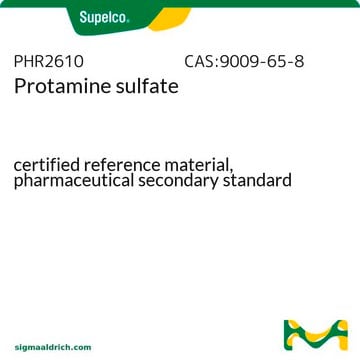P4530
Protamine-Agarose
saline suspension
Se connecterpour consulter vos tarifs contractuels et ceux de votre entreprise/organisme
About This Item
Numéro MDL:
Code UNSPSC :
41106500
Produits recommandés
Forme
saline suspension
Matrice
Cross-linked 4% beaded agarose
Activation de la matrice
cyanogen bromide
Fixation de matrice
amino
Espaceur de matrice
1 atom
Capacité
~50 μg/mL binding capacity (DNA)
Température de stockage
2-8°C
Application
Protamine-agarose is used in protein chromatography, affinity chromatography and specialty resins. Protamine-agarose has been used to determine that Pichia pastoris (methylotrophic yeast) provides a convenient heterologous system for the production of recombinant subunits of human type 2A protein phosphatase (PP2A). Protamine-agarose has also been used to purify and characterize a novel protamine kinase in HL60 cells as well as to study myocardial infarction.
Forme physique
Suspension in 0.5 M NaCl containing 0.02% thimerosal
Code de la classe de stockage
12 - Non Combustible Liquids
Classe de danger pour l'eau (WGK)
WGK 3
Point d'éclair (°F)
Not applicable
Point d'éclair (°C)
Not applicable
Certificats d'analyse (COA)
Recherchez un Certificats d'analyse (COA) en saisissant le numéro de lot du produit. Les numéros de lot figurent sur l'étiquette du produit après les mots "Lot" ou "Batch".
Déjà en possession de ce produit ?
Retrouvez la documentation relative aux produits que vous avez récemment achetés dans la Bibliothèque de documents.
I M Helander et al.
European journal of biochemistry, 163(1), 51-55 (1987-02-16)
The ability of agarose-linked protamine to bind Salmonella typhimurium lipopolysaccharides was investigated. Radioactively labelled lipopolysaccharides were isolated both from a smooth strain (SH6749, labelled with [14C]galactose) and from a rough strain (SH5014, lipopolysaccharide chemotype Rb2, labelled with [3H]acetate). From 50-micrograms
S Shibata et al.
Journal of biochemistry, 112(4), 552-556 (1992-10-01)
Calphobindins (CPBs, placental annexins) are intracellular Ca(2+)- and phospholipid-dependent proteins like protein kinase C [EC 2.7.1.37]. We investigated the inhibitory effects of calphobindins on the protein kinase C activity in vitro. CPB I inhibited the protein kinase C activity for
M Junco et al.
FEBS letters, 263(1), 169-171 (1990-04-09)
Protein kinase C (PKC) and its proteolysis-derived protein kinase independent of Ca2+ and phospholipids (PKM), were purified from rat brain. By using histone H1 and protamine as substrates, we assayed the effect of several inhibitors of PKC and PKM. The
V B Lokeshwar et al.
The Journal of biological chemistry, 264(32), 19318-19326 (1989-11-15)
Treatment of Swiss mouse 3T3 cells and human epidermoid carcinoma A431 cells with protamine at 37 degrees C increased the 125I-epidermal growth factor (EGF) binding activity at 4 degrees C. The effect of protamine on the increase of 125I-EGF binding
J L Rosales et al.
Journal of cellular physiology, 164(3), 509-521 (1995-09-01)
The role of ras on protein kinase C (PKC) signaling was examined in two keratinocyte cell lines. Increasing the level of extracellular calcium from 0.15 mM to 1.0 mM induces some features of differentiation in the spontaneously immortalized HaCaT line
Notre équipe de scientifiques dispose d'une expérience dans tous les secteurs de la recherche, notamment en sciences de la vie, science des matériaux, synthèse chimique, chromatographie, analyse et dans de nombreux autres domaines..
Contacter notre Service technique






